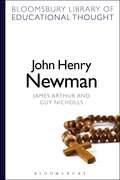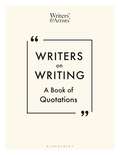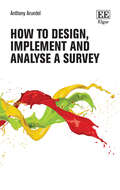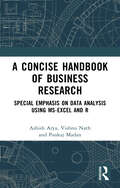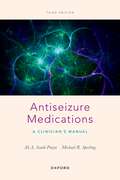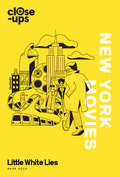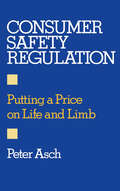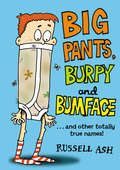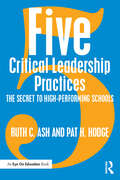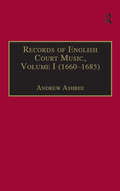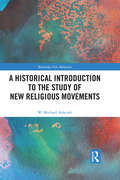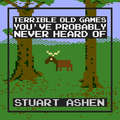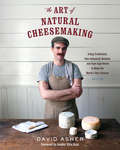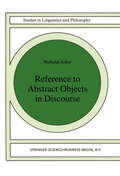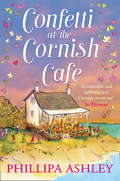- Table View
- List View
John Henry Newman (Bloomsbury Library of Educational Thought)
by James Arthur Guy NichollsJohn Henry Newman's writings and his lifelong search for religious truth continue to influence thought within a range of disciplines, most notably theology, philosophy and education. One of his most significant contributions was to the understanding of higher education contained within his nineteenth century writings, in particular his volume of lecturers entitled The Idea of a University, which has helped shape religious and educational thought over two centuries.Newman's claim that university education, the pursuit of universal knowledge and truth, is as much an education in pure and practical knowledge as in moral life, provides a continuing source of challenge and inspiration to education leaders today much as it did in the nineteenth century. James Arthur examines Newman's key strengths and weaknesses and locates these firmly within the intellectual context of his time, providing an overview of his work that allows students to appreciate the importance of his thought both within and outside the Catholic tradition.
Writers on Writing: A Book of Quotations (Writers' and Artists')
by Writers’ Artists’Writers on Writing brings together a plethora of phrases, quotable lines, quips and putdowns about the writing process. Arranged in themes that follow the stages from idea to final publication and beyond, this little book of quotations brings together words of wisdom and withering wit from famous and infamous writers across the ages about their own work and that of fellow writers. Themes on the publishing process include: getting started, first drafts, agents, editing, publication day, book tours; and on different genres, forms and writing styles, such as plot, character, dialogue. Other topics covered are: rivals, censorship, writer's block, spelling, fame, money, plagiarism, and alcohol. The quotations are accompanied by their original source (where known), date and a short writer biographical note. ''A writer is a person who writes.'' John Braine ''Our book is found to be a drug, no man needs it or heeds it. In the space of a year our publisher has disposed but of two copies.'' Charlotte Brontë ''How rare, how precious is frivolity! How few writers can prostitute all their powers! They are always implying, 'I am capable of higher things'.'' E.M. Forster
How to Design, Implement, and Analyse a Survey (How to Research Guides)
by Anthony ArundelThis insightful book examines all aspects of the design process and implementation of questionnaire surveys on the activities of business, public sector, and non-profit organizations. Anthony Arundel discusses how different aspects of the survey method and planned statistical analysis can constrain question design, and how these issues can be effectively resolved. Throughout this engaging yet practical book, Arundel promotes good practices for questionnaire design, sample construction, and survey delivery systems including online, postal, and verbal methods, with a focus on obtaining high-quality data in line with ethics and confidentiality requirements. Chapters include constructive advice on questionnaire design and testing, survey implementation, and data processing, analysis, and reporting, with examples of time and financial cost budgets. Considering the recent developments in survey methods, the book explores how to use web probing as a substitute for cognitive testing and examines the use of tablets and smartphones in answering questionnaires. Combining theoretical and practical insights into survey design, implementation, and data processing and analysis, this book will be essential reading for business and management scholars and students, with a particular interest in research methods and organization studies. It will also be useful for practitioners and business managers seeking to understand how to create and use surveys.
A Concise Handbook of Business Research: Special Emphasis on Data Analysis Using MS-Excel and R
by Ashish Arya Vishnu Nath Pankaj MadanThis book deals with the basics of Research Methodology (RM) for Business Research and statistical analysis for dealing with data using two software: R (a free statistical analysis environment) and MS-Excel. Apart from the basic concepts of Research Methodology, the book contains an additional chapter on improving academic writing. It contains important details on plagiarism, citation and referencing in MS-Word, and improving project/dissertation writing using free online software. Print edition not for sale in South Asia (India, Sri Lanka, Nepal, Bangladesh, Pakistan or Bhutan)
A Concise Handbook of Business Research: Special Emphasis on Data Analysis Using MS-Excel and R
by Ashish Arya Vishnu Nath Pankaj MadanThis book deals with the basics of Research Methodology (RM) for Business Research and statistical analysis for dealing with data using two software: R (a free statistical analysis environment) and MS-Excel. Apart from the basic concepts of Research Methodology, the book contains an additional chapter on improving academic writing. It contains important details on plagiarism, citation and referencing in MS-Word, and improving project/dissertation writing using free online software. Print edition not for sale in South Asia (India, Sri Lanka, Nepal, Bangladesh, Pakistan or Bhutan)
Antiseizure Medications: A Clinician's Manual
by Ali A. Asadi-Pooya Michael R. SperlingThis new edition of Antiseizure Medications: A Clinician's Manual reflects the advances in the study and treatment of epilepsy in the past several years. As a practical tool for physicians and other healthcare providers, this text focuses on the selection and use of antiseizure medications in a variety of clinical contexts. In the past decade, many new antiseizure medications (ASMs) have been introduced, so that there are now approximately 30 medications available to treat epilepsy. The healthcare provider therefore has many choices. However, having many alternatives also allows for the possibility of choosing an inappropriate or a suboptimal agent. The choice of medication should be guided by knowledge and familiarity with the ASMs. In this new edition, the authors discuss choosing drugs when faced with various medical comorbidities; how to correctly prescribe, titrate, and taper drugs; how to monitor drug efficacy and side effects; how to diagnose and manage toxicity; interactions with other drugs; and other relevant issues. With updated references, terminology, materials, and drugs, this third edition meets the needs of clinicians who must treat their patients living with epilepsy.
Antiseizure Medications: A Clinician's Manual
by Ali A. Asadi-Pooya Michael R. SperlingThis new edition of Antiseizure Medications: A Clinician's Manual reflects the advances in the study and treatment of epilepsy in the past several years. As a practical tool for physicians and other healthcare providers, this text focuses on the selection and use of antiseizure medications in a variety of clinical contexts. In the past decade, many new antiseizure medications (ASMs) have been introduced, so that there are now approximately 30 medications available to treat epilepsy. The healthcare provider therefore has many choices. However, having many alternatives also allows for the possibility of choosing an inappropriate or a suboptimal agent. The choice of medication should be guided by knowledge and familiarity with the ASMs. In this new edition, the authors discuss choosing drugs when faced with various medical comorbidities; how to correctly prescribe, titrate, and taper drugs; how to monitor drug efficacy and side effects; how to diagnose and manage toxicity; interactions with other drugs; and other relevant issues. With updated references, terminology, materials, and drugs, this third edition meets the needs of clinicians who must treat their patients living with epilepsy.
New York Movies (Close-Ups #3)
by Mark Asch Little White LiesThe indispensable, illustrated pocket guide to New York movies, from Martin Scorsese and Woody Allen to Lena Dunham and Noah Baumbach. ALSO AVAILABLE: Close-Ups: Wes Anderson Close-Ups: Vampire Movies
Consumer Safety Regulation: Putting A Price On Life And Limb
by Peter AschAdvocates of consumer safety regulation, an active and controversial area of public policy in the United States, contend that markets do not adequately protect the interests of vulnerable consumers; market traditionalists respond that public agencies increasingly make risk/safety decisions that individual citizens ought to be making for themselves. This book, written by an economist, critically assesses the rationales for, and the effects of, our major consumer safety programs. Addressed to a general audience, and incorporating relevant literature on cognitive psychology as well as economics, the author argues that although legitimate reasons for public protection of consumers exist in some markets, the particular programs we adopt often produce results that fall far short of what their advocates desire, and at least occasionally yield perverse outcomes.
Top 10 of London: 250 lists about London that will simply amaze you! (Top 10)
by Alexander AshNew from Hamlyn's bestselling Top 10 of Everything series comes a special collection of 250 fascinating lists guaranteed to intrigue and amaze you. With lists covering people, buildings, boroughs, art, transport, tourism, commerce and sport, Top 10 of London will open your eyes to just how diverse our capital city really is.Discover:- Why taxis are black- The rudest street names- Which attractions are more popular than the Taj Mahal, Statue of Liberty and Sydney Opera House- Bizarre building projects that were abandoned (including a 300ft pyramid covering Trafalgar Square)- That Venezuelans love London more than anyone else- That it has the most expensive office space in the world
Big Pants, Burpy and Bumface: And Other Totally True Names!
by Russell AshWhat's your name? Is it Chloe? Jessica? Jack, Sam? Is it Emily? Rebecca? Matthew, Dan?...Or is it Fart Bear? Noah Zark?Piggy Banks?Be grateful for your ordinary name - this funny, fascinating book is full of the silliest, the strangest, the weirdest and the wackiest names from around the world (and some of them are quite rude too)!
Top 10 for Men: Over 250 lists that matter (Top 10)
by Russell AshIt's a fact that men love lists: with lists, men can find the most interesting information with the least amount of effort. This book contains over 250 lists covering the most important subjects in life - cars, sports, barbecues, gadgets - and answers the most vital questions: Are Ferraris faster than Lamborghinis? What's the most common murder weapon? Who was the fattest Prime Minister? Which city has the highest proportion of women to men? What's the most alcholic beer in the world?No matter what your chosen subject may be, Top 10 for Men is a must for every pub-trivia king.
Top 10 of Britain: 250 quintessentially British lists (Top 10)
by Russell AshFrom the bestselling author of "Hamlyn's Top 10 of Everything" series comes a special collection of 250 unique lists that observe of the idiosyncrasies of our Isles and encompass everything British. Discover hundreds of essential, intriguing and bizarre facts about your country's most iconic subjects, including: the 10 most produced plays by Shakespeare; 10 defunct British national holidays; the 10 longest seaside piers; the 10 lowest-scoring UK Eurovision entries; the 10 latest winners of the World Conker Championships; the 10 first performed Gilbert & Sullivan operas; the Top 10 singles of all time banned by the BBC; 10 unusual British laws; the Top 10 Tesco's lines; the 10 latest winners of the Pub of the Year award ...plus 240 other fascinating lists in this at-a-glance guide to what makes Britain great.
Five Critical Leadership Practices: The Secret to High-Performing Schools
by Ruth C. Ash Pat H. HodgeWhat are the critical practices of leaders in high-performing schools? Based on extensive observations, interviews, and in-depth case studies of principals and superintendents who significantly increase student learning and achievement, this exciting new book provides novice and veteran school leaders with the five critical steps for effective school leadership: Focus on Direction Build a Powerful Organization Ensure Student-Focused Vision and Action Give Life to Data Lead Learning Rich with voices from highly effective leaders, this book provides an accessible, research-based framework for school improvement that is correlated with the field’s standards. The engaging case studies in this vital resource show the power of these five key critical practices to make a difference in the lives of students and transform schools to support learning for all.
Five Critical Leadership Practices: The Secret to High-Performing Schools
by Ruth C. Ash Pat H. HodgeWhat are the critical practices of leaders in high-performing schools? Based on extensive observations, interviews, and in-depth case studies of principals and superintendents who significantly increase student learning and achievement, this exciting new book provides novice and veteran school leaders with the five critical steps for effective school leadership: Focus on Direction Build a Powerful Organization Ensure Student-Focused Vision and Action Give Life to Data Lead Learning Rich with voices from highly effective leaders, this book provides an accessible, research-based framework for school improvement that is correlated with the field’s standards. The engaging case studies in this vital resource show the power of these five key critical practices to make a difference in the lives of students and transform schools to support learning for all.
Records of English Court Music: Volume I (1660-1685)
by Andrew AshbeePioneering work on the musical material from the archives of the English court was undertaken by Nagel (1894), Lafontaine (1909) and Stokes (in the Musical Antiquary 1903-1913). Records of English Court Music (a series of seven volumes covering the period 1485-1714) is the first attempt to compile a systematic calendar of such references. It aims to revise these earlier studies where necessary, adding significant details which researchers omitted, clarifying the context of documents and substituting current call-marks for defunct references. Volume V is primarily concerned with the post-Restoration years already partially covered in volumes I and II. The material from the Exchequer and Declared Accounts of the Treasurer of the Chamber has been revised to include references to trumpeters and drummers. Other sections are devoted to material outside the Lord Chamberlain's papers: the Signet Office Docquet Books, Secret Service accounts and more from the Exchequer; the Corporation of Musick (controlled by the Court musicians) and to the range of music material from accounts of the Receivers General. Samples from the comprehensive records of the Lord Steward's department (including those of the Cofferer of the Household) are also provided. Andrew Ashbee was the winner of the Oldman Prize in 1987 for Volume II in the series of 'Records of English Court Music', awarded by the UK branch of the International Association of Music Libraries for the year's best book on music librarianship, bibliography and reference.
Records of English Court Music: Volume I (1660-1685)
by Andrew AshbeePioneering work on the musical material from the archives of the English court was undertaken by Nagel (1894), Lafontaine (1909) and Stokes (in the Musical Antiquary 1903-1913). Records of English Court Music (a series of seven volumes covering the period 1485-1714) is the first attempt to compile a systematic calendar of such references. It aims to revise these earlier studies where necessary, adding significant details which researchers omitted, clarifying the context of documents and substituting current call-marks for defunct references. Volume V is primarily concerned with the post-Restoration years already partially covered in volumes I and II. The material from the Exchequer and Declared Accounts of the Treasurer of the Chamber has been revised to include references to trumpeters and drummers. Other sections are devoted to material outside the Lord Chamberlain's papers: the Signet Office Docquet Books, Secret Service accounts and more from the Exchequer; the Corporation of Musick (controlled by the Court musicians) and to the range of music material from accounts of the Receivers General. Samples from the comprehensive records of the Lord Steward's department (including those of the Cofferer of the Household) are also provided. Andrew Ashbee was the winner of the Oldman Prize in 1987 for Volume II in the series of 'Records of English Court Music', awarded by the UK branch of the International Association of Music Libraries for the year's best book on music librarianship, bibliography and reference.
A Historical Introduction to the Study of New Religious Movements (Routledge New Religions)
by W. Michael AshcraftThe American public’s perception of New Religious Movements (NRMs) as fundamentally harmful cults stems from the "anticult" movement of the 1970s, which gave a sometimes hysterical and often distorted image of NRMs to the media. At the same time, academics pioneered a new field, studying these same NRMs from sociological and historical perspectives. They offered an interpretation that ran counter to that of the anticult movement. For these scholars in the new field of NRM studies, NRMs were legitimate religions deserving of those freedoms granted to established religions. Those scholars in NRM studies continued to evolve methods and theories to study NRMs. This book tells their story. Each chapter begins with a biography of a key person involved in studying NRMs. The narrative unfolds chronologically, beginning with late nineteenth- and early-twentieth century perceptions of religions alternative to the mainstream. Then the focus shifts to those early efforts, in the 1960s and 1970s, to comprehend the growing phenomena of cults or NRMs using the tools of academic disciplines. The book’s midpoint is a chapter that looks closely at the scholarship of the anticult movement, and from there moves forward in time to the present, highlighting themes in the study of NRMs like violence, gender, and reflexive ethnography. No other book has used the scholars of NRMs as the focus for a study in this way. The material in this volume is, therefore, a fascinating viewpoint from which to explore the origins of this vibrant academic community, as well as analyse the practice of Religious Studies more generally.
A Historical Introduction to the Study of New Religious Movements (Routledge New Religions)
by W. Michael AshcraftThe American public’s perception of New Religious Movements (NRMs) as fundamentally harmful cults stems from the "anticult" movement of the 1970s, which gave a sometimes hysterical and often distorted image of NRMs to the media. At the same time, academics pioneered a new field, studying these same NRMs from sociological and historical perspectives. They offered an interpretation that ran counter to that of the anticult movement. For these scholars in the new field of NRM studies, NRMs were legitimate religions deserving of those freedoms granted to established religions. Those scholars in NRM studies continued to evolve methods and theories to study NRMs. This book tells their story. Each chapter begins with a biography of a key person involved in studying NRMs. The narrative unfolds chronologically, beginning with late nineteenth- and early-twentieth century perceptions of religions alternative to the mainstream. Then the focus shifts to those early efforts, in the 1960s and 1970s, to comprehend the growing phenomena of cults or NRMs using the tools of academic disciplines. The book’s midpoint is a chapter that looks closely at the scholarship of the anticult movement, and from there moves forward in time to the present, highlighting themes in the study of NRMs like violence, gender, and reflexive ethnography. No other book has used the scholars of NRMs as the focus for a study in this way. The material in this volume is, therefore, a fascinating viewpoint from which to explore the origins of this vibrant academic community, as well as analyse the practice of Religious Studies more generally.
Terrible Old Games You've Probably Never Heard Of
by Stuart AshenTerrible Old Games You've Probably Never Heard Of is a full-colour illustrated compendium of the most painfully bad games, based on Ashens' YouTube series of the same name.Everyone's heard of E.T. for the Atari 2600 and Superman for the Nintendo 64, but these are almost nothing next to the abject incompetence of Count Duckula 2 on the Amstrad CPC. There are people who seriously believe that Shaq Fu is the worst fighting game ever made, having never experienced Dangerous Streets on the Amiga. This book will blow their very soul apart. (Not a guarantee.)Terrible Old Games You've Probably Never Heard Of is meticulously researched and written, with the dry humour you'd expect from a man who has somehow made a living by sticking rubbish on a sofa and talking about it. Each entry is accompanied by a series of full-colour images from the games.
The Art of Natural Cheesemaking: Using Traditional, Non-Industrial Methods and Raw Ingredients to Make the World's Best Cheeses
by David Asher Sandor Ellix KatzIncluding more than 35 step-by-step recipes from the Black Sheep School of Cheesemaking Most DIY cheesemaking books are hard to follow, complicated, and confusing, and call for the use of packaged freeze-dried cultures, chemical additives, and expensive cheesemaking equipment. For though bread baking has its sourdough, brewing its lambic ales, and pickling its wild fermentation, standard Western cheesemaking practice today is decidedly unnatural. In The Art of Natural Cheesemaking, David Asher practices and preaches a traditional, but increasingly countercultural, way of making cheese—one that is natural and intuitive, grounded in ecological principles and biological science. This book encourages home and small-scale commercial cheesemakers to take a different approach by showing them: • How to source good milk, including raw milk; • How to keep their own bacterial starter cultures and fungal ripening cultures; • How make their own rennet—and how to make good cheese without it; • How to avoid the use of plastic equipment and chemical additives; and • How to use appropriate technologies. Introductory chapters explore and explain the basic elements of cheese: milk, cultures, rennet, salt, tools, and the cheese cave. The fourteen chapters that follow each examine a particular class of cheese, from kefir and paneer to washed-rind and alpine styles, offering specific recipes and handling advice. The techniques presented are direct and thorough, fully illustrated with hand-drawn diagrams and triptych photos that show the transformation of cheeses in a comparative and dynamic fashion. The Art of Natural Cheesemaking is the first cheesemaking book to take a political stance against Big Dairy and to criticize both standard industrial and artisanal cheesemaking practices. It promotes the use of ethical animal rennet and protests the use of laboratory-grown freeze-dried cultures. It also explores how GMO technology is creeping into our cheese and the steps we can take to stop it. This book sounds a clarion call to cheesemakers to adopt more natural, sustainable practices. It may well change the way we look at cheese, and how we make it ourselves.
Reference to Abstract Objects in Discourse (Studies in Linguistics and Philosophy #50)
by Nicholas AsherReference to Abstract Objects in Discourse presents a novel framework and analysis of the ways we refer to abstract objects in natural language discourse. The book begins with a typology of abstract objects and related entities like eventualities. After an introduction to `bottom up, compositional' discourse representation theory (DRT) and to previous work on abstract objects in DRT (notably work on the semantics of the attitudes), the book turns to a semantic analysis of eventuality and abstract object denoting nominals in English. The book then substantially revises and extends the dynamic semantic framework of DRT to develop an analysis of anaphoric reference to abstract objects and eventualities that exploits discourse structure and the discourse relations that obtain between elements of the structure. A dynamic, semantically based theory of discourse structure (SDRT) is proposed, along with many illustrative examples. Two further chapters then provide the analysis of anaphoric reference to propositions VP ellipsis. The abstract entity anaphoric antecedents are elements of the discourse structures that SDRT develops. The final chapter discusses some logical and philosophical difficulties for a semantic analysis of reference to abstract objects. For semanticists, philosophers of language, computer scientists interested in natural language applications and discourse, philosophical logicians, graduate students in linguistics, philosophy, cognitive science and artificial intelligence.
Confetti at the Cornish Café: The Perfect Summer Romance For Fans Of Poldark (The Cornish Café Series #3)
by Phillipa AshleyAn escapist read that’s as good as a holiday! ‘Warm and funny and feel-good. The best sort of holiday read’ Katie Fforde ‘Filled with warm and likeable characters. Great fun!’ Jill Mansell
The Calling Card Script: A writer's toolbox for screen, stage and radio
by Paul AshtonThe calling card script is the script that expresses your voice, gets you noticed and helps you reach commission and production. Written by Paul Ashton, Development Manager of the BBC writersroom, and born out of his wide experience of reading scripts, working with writers, and as an industry 'gatekeeper', this is a guide to the key writing tools you need to know and understand to write a truly original script.As many professionals need to switch mediums and genres in order to survive and thrive, the book uniquely draws together the universal principles of dramatic storytelling for screen, stage, and radio. With a focus on the script as a blue print for performance, sections and chapters break down into bite-sized practical insights and the book mirrors both the journey of the story and process of writing it. The Calling Card Script shows how to tell a great story in script form and offers valuable professional development insight for all writers, whether established or just starting out, who wish to hone their craft and speak their voice.
The Calling Card Script: A writer's toolbox for screen, stage and radio
by Paul AshtonThe calling card script is the script that expresses your voice, gets you noticed and helps you reach commission and production. Written by Paul Ashton, Development Manager of the BBC writersroom, and born out of his wide experience of reading scripts, working with writers, and as an industry 'gatekeeper', this is a guide to the key writing tools you need to know and understand to write a truly original script.As many professionals need to switch mediums and genres in order to survive and thrive, the book uniquely draws together the universal principles of dramatic storytelling for screen, stage, and radio. With a focus on the script as a blue print for performance, sections and chapters break down into bite-sized practical insights and the book mirrors both the journey of the story and process of writing it. The Calling Card Script shows how to tell a great story in script form and offers valuable professional development insight for all writers, whether established or just starting out, who wish to hone their craft and speak their voice.
